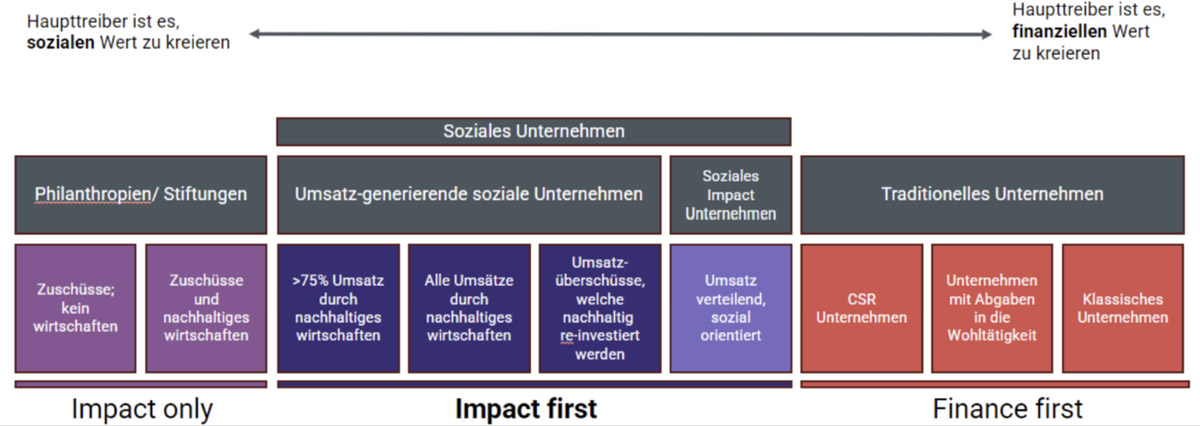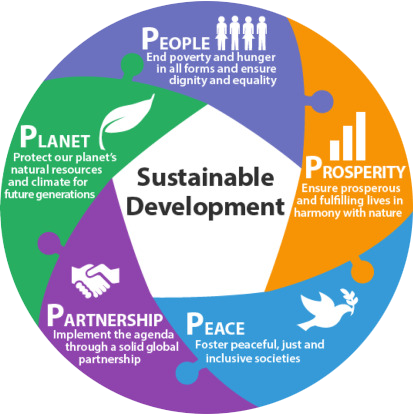Business models with impact
Michelle Obama once said: "Success isn't about how much money you make; it's about the difference you make in people's lives." This statement succinctly summarises the core idea behind social business models. It's not just about profit, but about the added social value that a company creates. But what does this mean in concrete terms and how can such models be categorised and developed?
1. the spectrum of social business models
The world of companies is colourful and diverse, especially when it comes to the value they create. The spectrum ranges from organisations that primarily create social value to those that primarily generate financial value.

Figure 1: Spectrum of social business models (own illustration iAa. EVPA 2011)
Foundations and charitable organisations are at one end of the spectrum. They are often funded by donations and aim to tackle social challenges directly without making a financial profit.
Further in the centre, we find revenue-generating social enterprises that pursue both financial and social goals. They generate revenue through the sale of products or services that have a social impact. Examples include Viva con Agua, which campaigns for access to clean water, and Patagonia, which produces sustainable clothing.
Impact companies are those that have a clear focus on social goals but still operate profitably. They invest their surpluses in achieving their social mission. One example of this is Fairphone, which offers sustainably produced smartphones.
At the other end of the spectrum are traditional companies that are primarily focussed on creating financial value. However, some of them, such as Ben & Jerry's, also combine their business model with social aspects, for example by supporting fair trade practices.
1.2 Sustainability in business models
According to the classic definition, sustainability can be understood as the principle of using and managing resources in such a way that ecological, social and economic needs are met without compromising the ability of future generations to meet their own needs. Sustainable business models are therefore those that integrate this principle into the core of their strategy.
The 5Ps of sustainability can be used to realise this. They represent a practical approach to the more comprehensive 17 Sustainable Development Goals (SDGs) of the United Nations:
- People: Promoting human well-being and social justice.
- Prosperity: Economic success that is not at the expense of the other P's.
- Planet: Conserving natural resources and minimising the ecological footprint.
- Partnership: Collaboration with various stakeholders to promote sustainable goals.
- Peace: Contribution to a stable and peaceful society.

Figure 2: 5 Critical Components / 5P's (United Nations System Staff College)
The 5P's of sustainability must be viewed in the context of their impact and offer a manageable and practical guideline for entrepreneurs to anchor sustainability holistically in their corporate structures and should already be taken into account in the process of developing a sustainable business model.
1.3 Advantages of sustainable business models
Implementing sustainability principles in business models is not just a moral or environmental decision, but also brings with it a number of strategic benefits. These potential benefits can contribute to the strengthening and long-term success of a company:
- Increased resilience and risk management: Sustainability-orientated companies are often better able to deal with environmental, social and governance risks. They are geared towards long-term stability and can therefore respond better to changes and challenges.
- Promotion of innovations: The focus on sustainability often requires innovative approaches and can therefore act as a catalyst for new ideas and products.
- Improved brand perception: A commitment to sustainability strengthens a company's image. Customers and business partners increasingly value companies that are committed to environmental and social issues.
- Employee commitment and loyalty: Sustainable corporate governance can increase employee motivation and loyalty. Many people want to work for a company that reflects their values and makes a positive contribution to society.
- Access to new markets: Sustainable business models can open doors to new customer groups that value environmentally friendly and socially responsible products.
- Legal and tax advantages: In some regions, there are financial incentives for companies that implement sustainable practices, such as tax breaks or subsidies.
- Attractiveness for investors: A clearly defined sustainability concept can attract the interest of investors, especially those who value social responsibility and environmental awareness.
- Increase in efficiency: Sustainable practices, such as the efficient use of resources, can lead to cost savings and increase operational efficiency.
These potential benefits make it clear that a sustainable business model is not only beneficial for society, but also for the company itself.
2. social business model canvas: the foundation of socially sustainable business models
The Social Business Model Canvas (SBMC) is an adaptation of the well-known Business Model Canvas (BMC) and was developed specifically for social enterprises. While the BMC is mainly focussed on creating and delivering value for customers, the SBMC adds the social dimension to this perspective. It helps to integrate the social mission, core values and long-term social impact into the business strategy.
2.1 The elements of the Social Business Model Canvas
The SBMC is an interactive and iterative working basis that should be gradually filled in by the company.

Figure 3: Social Business Model Canvas (own illustration)
Just like the Business Model Canvas, the Social Business Model Canvas also consists of various elements:
- Key Value Proposition: Describes the unique value the company creates for its customers and other stakeholders.
- Customer Segments: The target groups that the company wants to address.
- Channels (sales channels): The ways and means by which the company reaches and interacts with its customers.
- Customer Relationships: The type of relationship that the company establishes and maintains with its customers.
- Key Activities: The most important activities that the company must perform in order to deliver its value proposition.
- Key Resources: The resources required to carry out the key activities.
- Key Partnerships: Important partnerships and networks that support the company.
- Cost Structure: The costs associated with operating the business model.
- Revenue streams: The company's sources of income.
- Socio-economic costs: This element includes the social and environmental costs that may arise from business activities and is crucial for assessing the company's overall impact.
- Socio-economic benefits: The positive social and environmental impact of the company is assessed here, which is a key aspect for social enterprises.
2.2 From the social business model canvas to impact
By utilising the SBMC, entrepreneurs can ensure that their main concern - social impact - is considered at every stage of their business operations and development. It is a framework that helps to maintain focus, utilise resources efficiently and ultimately bring about sustainable change in society.
In practice, this means that a social enterprise like Too Good To Go would use the SBMC to clearly define how it reduces food waste, communicates with all stakeholders and strategically deploys its resources to be both commercially successful and have a positive social impact.
2.3 Application of the Social Business Model Canvas
To apply the SBMC, organisations typically start with the mission and stakeholders to have a clear understanding of their social goals. From there, the other elements are developed, with the social mission always serving as a guiding star.
Hypotheses are made for each element, which are then tested and adapted through interaction with stakeholders. This iterative process helps to develop a robust and responsive business model that is not only economically viable but also creates significant social value.
Core steps:
- Defining the social mission: Clarify what social contribution your company would like to make.
- Identify the stakeholders: Determine who is influenced by your company and who you influence.
- Developing the business model: Formulate hypotheses for each element of the SBMC, from the value proposition to the socio-economic costs and benefits.
- Test and customise: Check these hypotheses with feedback from stakeholders and adjust your model accordingly.
The SBMC is not only an iterative planning tool, but also a communication tool. It enables social enterprises to clearly communicate their vision and gain support from investors, partners and the community.
For in-depth support and individual counselling, AiDiA offers Specialised coaching sessions that support entrepreneurs in effectively designing and implementing their business model.
3. summary: The power of the Social Business Model Canvas
The SBMC is more than just a tool. It is a guide for all those who want to change the world with their entrepreneurship. It helps us to put Henry Ford's oft-repeated quote - "A business that only makes money is a bad business." - into action. With the SBMC, a company can ensure that it not only creates economic value, but also social value and thus contributes to a better world.
From theory to practice
By using the SBMC, entrepreneurs can clearly define their mission and develop strategies to make a real difference in society. It's about bridging the gap between financial viability and social impact and developing a business model that balances both aspects.
Measurable impact
A crucial aspect of SBMC is the measurability of social impact. Organisations need to be able to quantify the success of their efforts in order to continuously adapt and improve their mission and goals. The SBMC provides the structure to set impact goals and track progress towards these goals.
Future-orientated business models
The SBMC enables companies to create future-orientated business models. At a time when the call for sustainability is growing louder, it provides a framework for companies to develop innovative solutions that are both economically viable and socially meaningful.
4 Review and outlook: From vision to reality
The workshop "From Purpose to Profit - Develop your Impact Business Model", which took place on 14 November with the kind support of Georgis Tesfamariam and Rajiv Nehring (both Contio GmbH) was a vivid example of what the Social Business Model Canvas looks like in action. Participants not only gained deep insights into the development of business models that generate real social impact, but also practical tools to translate their visions into measurable results.
Experiences and insights from the workshop
In interactive sessions, participants were encouraged to scrutinise and refine their business ideas. By exchanging ideas with like-minded people and receiving feedback from experts, they were able to gain new perspectives and put their models through their paces. The central theme was how social innovations can not only be conceptualised, but also effectively implemented.
The next steps
The workshop was just a starting point. The Social Impact Weeks, which are organised via the Social Impact Weeks offer a wealth of further opportunities to deepen what has been learnt and expand networks. The upcoming events are designed to support and inspire entrepreneurs in their quest for social impact.
An outlook for the future
In the Social Impact Weeks, we cover topics such as impact measurement, financing social enterprises and scaling strategies. Each event aims to provide practical skills while fostering dialogue and collaboration between social entrepreneurship stakeholders.
"Social entrepreneurship: where innovation meets social responsibility, solutions are created that generate more than just profit." - These words by Georgis Tesfamariam reflect the spirit of the Social Impact Weeks and invite everyone who not only wants to be successful in business, but also wants to make a positive contribution to society.
© Photo from Justyn Warner on Unsplash

